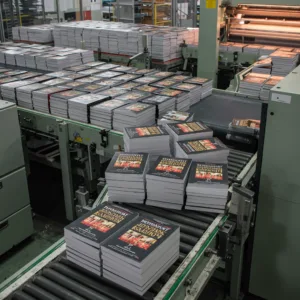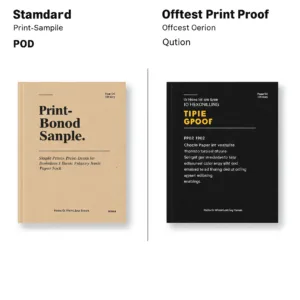Thinking about using Print-on-Demand (POD) for your essential pre-production book printing samples? It’s fast and affordable, but POD has critical limitations compared to traditional proofs that every author and publisher must understand before committing to a mass print run. This guide delivers the actionable insights you need to decide if POD samples are right for your project.
Print-on-Demand (POD) is suitable for book printing samples primarily to verify digital file accuracy, check layout, and assess basic physical size/feel at a low cost. However, POD samples cannot reliably preview final offset print quality, precise color matching, specific paper stocks, or special cover finishes like foil or embossing.
Want the detailed breakdown? See exactly when POD excels, where it falls short (with real examples), and get actionable workflows to guarantee you choose the right sampling strategy for your book launch. Let’s ensure your book printing samples set you up for success.
Why Sample? Understanding the Stakes Before You Print

You might be thinking, “My digital files look perfect on screen, why bother with a physical sample?” It’s a common thought, especially when you’re eager to launch. However, skipping the sampling stage can be a costly decision, not just financially, but also for your book’s reputation.
Think about the potential printing mistakes: discovering a layout issue, an overlooked typo, or unexpected color shifts after you’ve printed hundreds, or even thousands, of copies. Fixing those mistakes means wasted inventory, reprint costs, and potential delays – turning your exciting launch into a logistical headache. This is where sampling becomes crucial.
Consider the cost of a sample not as an extra expense, but as valuable insurance against much larger potential losses. Here’s why taking the time to get a physical sample is so important:
- Catch Errors You Missed: Holding a physical book often reveals errors – awkward page breaks, margin issues, typos – that are easily overlooked on a screen. It’s your last chance for a critical proofread in the actual format.
- Validate Design Choices: Does the cover design translate well to a physical object? Is the font size truly comfortable for reading? Is the paper thickness appropriate? A sample gives you tangible answers.
- Build Confidence: Seeing and approving a physical copy provides peace of mind before you commit to the main print run. It confirms your choices and reduces launch-day anxiety.
- The Power of Physical: There’s something about holding a physical book. Many find that having a tangible object provides greater confidence in decision-making compared to just reviewing a PDF (reflecting the “Physical Object Credibility” insight). It allows you to experience the book more closely to how your readers will.
Understanding these stakes helps clarify why sampling matters. But not all samples are created equal. Let’s look at the different types you might encounter.
POD Samples vs. Traditional Proofs
Okay, so you’re convinced sampling is essential. But when people talk about “samples” or “proofs,” they might mean different things. Understanding these terms, especially in the US market, is key to getting what you actually need.
Defining the Terms for the US Market
Let’s clarify the common types of pre-production copies:
- POD Sample / Proof Copy: This is typically what authors and publishers order directly from Print-on-Demand platforms like Amazon KDP or IngramSpark. You usually order just one or a few copies. Its primary purpose is internal review – checking your digital files (layout, typos, margins) in a physical format before you make the book available for sale or send it for a larger print run. The quality reflects the standard POD printing process of that specific platform.
- Traditional Printer Proofs: These come from your chosen offset or short-run digital printer. They exist to show you exactly how your book will look when mass-produced using their specific equipment and materials. Proofs can range from:
- Digital Proofs: Often PDFs showing final layout, colors (on screen), and trapping, but not physical.
- Contract Proofs: High-accuracy physical prints (often just key pages or the cover) calibrated to predict the final offset press results, especially for color.
- Physical Mock-ups: A bound copy using the correct paper and size, but possibly with blank pages or lower-quality print, just to check bulk, binding, and feel.
- Press Checks: You physically go to the printer to approve sheets as they come off the press (usually for high-stakes, large runs). The goal here is final quality approval before the main run.
Key Differences at a Glance
Understanding the fundamental differences helps you choose the right tool for the job:
- Cost & Turnaround Time: POD samples are inexpensive (often $5-$20) and arrive quickly (usually within days). Traditional proofs vary widely in cost (from $50 for simple digital proofs to $500+ for complex physical proofs or press checks) and take longer (days to weeks).
- Minimum Order Quantity (MOQ): For both POD samples and traditional proofs, the MOQ is typically just 1 copy.
- Quality & Consistency: This is a major differentiator when considering Offset vs POD. POD quality is standard for that platform and can vary between copies or print locations, while traditional proofs aim to precisely represent the high quality and consistency of the final offset run.
- Paper & Binding Options: POD platforms offer a limited menu of standard paper stocks and binding types. Traditional proofs should use the exact paper, binding, and finishing specified for your final production run.
- Color Accuracy: POD uses automated CMYK conversions, leading to potential color shifts and variability, unlike traditional proofs where meticulous pre-print color management allows for accurate matching.
- Special Finishes: Standard POD generally cannot replicate foil stamping, embossing, debossing, spot UV, or die-cuts. Traditional proofs can and should show these if they are part of your final design.
Quick Comparison Table
Here’s a simple table summarizing the main points:
| Feature | POD Sample (Internal Check) | Traditional Offset Proof (Quality Approval) |
|---|---|---|
| Primary Goal | File/Layout Check, Basic Feel | Final Quality/Color/Finish Approval |
| Cost | Low | Higher |
| Speed | Fast | Slower |
| MOQ | 1 | 1 |
| Color Accuracy | Variable Approximation | High (Predictive of Final Run) |
| Paper/Binding | Limited Standard Options | Matches Final Specs |
| Special Finishes | No | Yes |
| Consistency | Variable | High (Represents Bulk Run) |
When is POD Sampling the Smart Choice? (And When Isn’t It?)

Knowing the difference between sample types is one thing; knowing which one is right for your specific book project is another. Print-on-Demand (POD) sampling offers compelling advantages in certain situations, but it has significant limitations you need to understand to avoid disappointment or costly assumptions.
The POD Sample Sweet Spot: What It Excels At
POD sampling is often a smart, cost-effective choice when your primary goals align with its strengths. Consider using a POD sample if:
- Your Book is Primarily Text: For novels, memoirs, standard non-fiction, or any book where text is the main component and images are minimal or simple black-and-white, POD samples work well.
- Your Main Goal is File Verification: This is where POD truly shines. It’s an excellent, low-cost way to catch layout issues, check margins, ensure readability, spot typos you missed on screen, and confirm the physical size and page count feel right.
- Consider Evergreen Press: They successfully used POD samples for internal review and final proofreading of classic texts, leveraging POD’s speed and low cost to catch file errors efficiently.
- You Need Fast, Affordable Iteration: If you anticipate needing multiple rounds of revisions based on physical checks, the low cost (often under $20) and quick turnaround (days) of POD samples make iteration feasible without breaking the bank. This directly addresses the author’s need for controlled 改版成本 (revision costs).
Red Flags: When to Avoid Relying Solely on POD Samples

While great for file checks, POD samples are often not the right tool if your book relies heavily on elements that POD technology struggles with. Be cautious if:
- High-Fidelity Color is Crucial: For art books, photography collections, or any project demanding precise color reproduction or matching specific brand colors (Pantones), POD’s variable CMYK output is unlikely to meet your needs.
- Think of Michael the photographer: His POD sample showed noticeable color shifts and couldn’t deliver the “gallery quality” his art book required.
- Specific Paper Quality is Key: If your book’s appeal depends on a unique paper texture, heavy weight, or special feel, the limited standard stocks offered by POD platforms won’t provide an accurate preview.
- Special Finishes are Planned: As publishing consultant Karin Wiberg notes, standard POD simply doesn’t offer options like foil stamping, embossing, debossing, or spot UV. You cannot use a POD sample to preview these tactile and visual enhancements.
- Remember Emily the fantasy author: Her POD sample could only show a flat yellow area where the beautiful gold foil title was supposed to be – completely failing to preview the intended effect.
- A Premium “Luxury” Feel is Desired: Due to limitations in paper, binding (especially for hardcovers, which are typically glued, not sewn), and lack of finishes, a POD sample rarely achieves the high-end, luxurious feel possible with quality offset printing.
Decision Helper: A Quick Checklist
Not sure if POD sampling fits your project? Ask yourself these questions:
- Color Needs: Is “close enough” okay, or do you need precise, consistent color matching?
- Paper Feel: Is standard paper acceptable, or is a specific texture/weight essential to the book’s experience?
- Cover Finishes: Does your design include foil, embossing, spot UV, or other tactile elements?
- Primary Goal: Are you mainly checking the layout and proofreading the file, OR do you need to approve the final print quality, color, and materials?
- Budget vs. Risk: Is minimizing the initial sample cost your top priority, even if it doesn’t fully represent the final product? Or is reducing the risk of an imperfect final print run more critical, justifying a higher proofing cost?
Answering these honestly will guide you toward the most appropriate sampling method for your specific needs and budget.
Tailored Sampling Strategies: Workflows for Authors & Publishers
Okay, you understand the pros and cons of POD sampling. Now, how do you actually use this knowledge? Your best approach depends on whether you’re an independent author managing everything yourself or a small publisher coordinating with a team. Here are two suggested workflows:
For the Indie Author: The “Zero Waste Proof” Workflow
As an indie author, especially if it’s your first book, budget and efficiency are often top priorities. Your goal is likely to perfect your files before committing to inventory or wider distribution. This workflow focuses on using POD samples primarily as a file-checking tool:
- Finalize Digital Files: Before even thinking about a sample, ensure your interior and cover files are meticulously prepared. This means proper formatting, high-resolution images (300 DPI), correct bleed and trim settings, embedded fonts, and appropriate color profiles (like GRACoL for US printing, though check specific POD platform requirements). Use pre-flight tools in software like Adobe Acrobat if possible.
- Order Your POD Sample(s): Upload your files to your chosen POD platform(s). Consider ordering from more than one platform—resources are available comparing KDP vs. IngramSpark services which can reveal subtle differences—simultaneously. While this costs slightly more, comparing the results can give you valuable insights into subtle differences in paper, color handling, and binding, helping you make better final decisions. When the samples arrive, focus your review entirely on layout accuracy, readability, catching typos, and getting a basic feel for the size and weight.
- Iterate as Needed: Did you find errors? Fix them in your digital files. If the changes were significant (affecting pagination or major layout elements), order another POD sample to confirm the fixes. The low cost makes this iteration affordable.
- Make the Decision: Once you have a POD sample confirming your files are accurate and the basic layout works, decide your next step. Is the POD quality sufficient for your intended market and book type? If yes, you might proceed with POD for sales. If not (e.g., you need better paper, color, or special finishes), use your now-perfected digital file to request a high-fidelity proof from your chosen offset or short-run printer.
For the Small Publisher: The “Dual Track” Approach
Small publishers often juggle team reviews, tighter deadlines, and the need to ensure professional quality that reflects their brand. A “dual track” approach can balance speed, internal needs, and quality control:
- Rapid POD Samples for Internal Use: As soon as files are ready for review, order a small number of POD samples. These can be distributed quickly and affordably to the editorial team, marketing, or a selection committee. Having a physical object often facilitates better discussions and feedback than PDFs alone (addressing the psychological need for tangibility). Use this stage for final team proofreading and basic layout approval. Remember to manage expectations – brief your team on what POD samples can and cannot show regarding final quality.
- Initiate Professional Proofing: Simultaneously, or immediately after the internal POD check confirms the file basics, request appropriate proofs (digital color proofs, physical mock-ups, or contract proofs covering critical sections/cover) from your selected offset or short-run printer. This process, while slower, is focused purely on final quality sign-off – accurate color, paper feel, binding, and any special finishes.
- Combine Insights for Approval: Make the final print run decision based on both inputs: confirmation that the digital files are correct (validated by the POD sample check) and approval of the print quality (validated by the professional proofs from your production printer). This approach leverages the speed and low cost of POD for internal steps while ensuring final quality through traditional proofing methods.
How to Critically Evaluate Your POD Sample
When your sample arrives, resist the urge to judge it solely on whether it looks like your “dream book.” Instead, use it strategically as that “Digital File Health Report”. Focus your evaluation:
What TO Check Carefully:
- [ ] Layout & Formatting: Are margins correct? Is text flow right (no weird breaks, widows/orphans)? Are chapter headings consistent?
- [ ] Readability: Is the font size comfortable? Is the line spacing adequate?
- [ ] Image Placement & Clarity: Are images positioned correctly? Are they reasonably clear (assuming 300 DPI was used)? (For B&W books, how did the grayscale conversion look?)
- [ ] Typos & Errors: Do a thorough proofread! Errors are often easier to spot on paper.
- [ ] Page Order & Numbering: Is everything in the correct sequence?
- [ ] Trim Size & Basic Feel: Does the physical size feel right? Does the page count create the expected bulk?
- [ ] Spine Alignment (within tolerance): Is the spine text reasonably centered?
What TO Actively IGNORE (or view with caution):
- [ ] Precise Color Matching: Don’t expect colors to perfectly match your screen or how they might look in an offset run. Note major, unexpected shifts, but don’t obsess over nuances.
- [ ] Paper Quality & Texture: Unless comparing different POD platforms, accept the standard POD paper for what it is. It won’t feel like premium offset paper.
- [ ] Binding Durability (if moving to offset): POD binding (especially perfect binding) is generally functional but may not be as robust as offset Smyth-sewn binding.
- [ ] Special Finish Previews: Flat colors where foil/embossing should be tell you nothing about the actual effect.
By focusing your review this way, you extract the maximum practical value from your POD book printing sample.
Conclusion: Making the Right Sampling Choice for Your Book
Choosing the right book printing sample method is key. POD offers a cost-effective way to verify your digital files, check layout, and get a basic physical feel for your book. However, remember its limitations: it cannot accurately preview final offset print quality, precise color, unique paper textures, or special finishes.
Before ordering, define what critical questions your sample needs to answer. Then, match your method—whether low-cost POD, a higher-quality short-run proof, or a professional offset proof—to those specific needs. This informed choice is crucial for a smooth transition to mass production and a final book you’ll be proud of.







